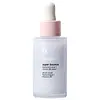What's inside
What's inside
 Key Ingredients
Key Ingredients

 Benefits
Benefits

 Concerns
Concerns

 Ingredients Side-by-side
Ingredients Side-by-side

Dimethicone
EmollientXanthan Gum
EmulsifyingSorbitan Sesquioleate
EmulsifyingHydroxyethylcellulose
Emulsion StabilisingWater
Skin ConditioningPropanediol
SolventGlycereth-26
HumectantPEG-12 Dimethicone
Skin ConditioningSodium Hyaluronate
HumectantAminomethyl Propanol
BufferingBiosaccharide Gum-2
Skin ConditioningPanthenol
Skin ConditioningCitric Acid
BufferingBenzophenone-4
UV AbsorberLonicera Caprifolium Flower Extract
PerfumingPhenoxyethanol
PreservativeEthylhexylglycerin
Skin ConditioningDehydroacetic Acid
PreservativeBenzyl Alcohol
PerfumingHc Violet No. 1
CI 42090
Cosmetic ColorantDimethicone, Xanthan Gum, Sorbitan Sesquioleate, Hydroxyethylcellulose, Water, Propanediol, Glycereth-26, PEG-12 Dimethicone, Sodium Hyaluronate, Aminomethyl Propanol, Biosaccharide Gum-2, Panthenol, Citric Acid, Benzophenone-4, Lonicera Caprifolium Flower Extract, Phenoxyethanol, Ethylhexylglycerin, Dehydroacetic Acid, Benzyl Alcohol, Hc Violet No. 1, CI 42090
Water
Skin ConditioningEthylhexyl Palmitate
EmollientGlycerin
HumectantCaprylic/Capric Triglyceride
MaskingPropanediol
SolventBiosaccharide Gum-2
Skin ConditioningSodium Hyaluronate
HumectantPanthenol
Skin ConditioningMethyl Glucose Sesquistearate
EmollientXanthan Gum
EmulsifyingAcrylates/C10-30 Alkyl Acrylate Crosspolymer
Emulsion StabilisingDisodium EDTA
1,2-Hexanediol
Skin ConditioningCaprylyl Glycol
EmollientChlorphenesin
AntimicrobialSodium Hydroxide
BufferingWater, Ethylhexyl Palmitate, Glycerin, Caprylic/Capric Triglyceride, Propanediol, Biosaccharide Gum-2, Sodium Hyaluronate, Panthenol, Methyl Glucose Sesquistearate, Xanthan Gum, Acrylates/C10-30 Alkyl Acrylate Crosspolymer, Disodium EDTA, 1,2-Hexanediol, Caprylyl Glycol, Chlorphenesin, Sodium Hydroxide
 Reviews
Reviews

Ingredients Explained
These ingredients are found in both products.
Ingredients higher up in an ingredient list are typically present in a larger amount.
We don't have a description for Biosaccharide Gum-2 yet.
Panthenol is a common ingredient that helps hydrate and soothe the skin. It is found naturally in our skin and hair.
There are two forms of panthenol: D and L.
D-panthenol is also known as dexpanthenol. Most cosmetics use dexpanthenol or a mixture of D and L-panthenol.
Panthenol is famous due to its ability to go deeper into the skin's layers. Using this ingredient has numerous pros (and no cons):
Like hyaluronic acid, panthenol is a humectant. Humectants are able to bind and hold large amounts of water to keep skin hydrated.
This ingredient works well for wound healing. It works by increasing tissue in the wound and helps close open wounds.
Once oxidized, panthenol converts to pantothenic acid. Panthothenic acid is found in all living cells.
This ingredient is also referred to as pro-vitamin B5.
Learn more about PanthenolPropanediol is an all-star ingredient. It softens, hydrates, and smooths the skin.
It’s often used to:
Propanediol is not likely to cause sensitivity and considered safe to use. It is derived from corn or petroleum with a clear color and no scent.
Learn more about PropanediolSodium Hyaluronate is hyaluronic acid's salt form. It is commonly derived from the sodium salt of hyaluronic acid.
Like hyaluronic acid, it is great at holding water and acts as a humectant. This makes it a great skin hydrating ingredient.
Sodium Hyaluronate is naturally occurring in our bodies and is mostly found in eye fluid and joints.
These are some other common types of Hyaluronic Acid:
Learn more about Sodium HyaluronateWater. It's the most common cosmetic ingredient of all. You'll usually see it at the top of ingredient lists, meaning that it makes up the largest part of the product.
So why is it so popular? Water most often acts as a solvent - this means that it helps dissolve other ingredients into the formulation.
You'll also recognize water as that liquid we all need to stay alive. If you see this, drink a glass of water. Stay hydrated!
Learn more about WaterXanthan gum is used as a stabilizer and thickener within cosmetic products. It helps give products a sticky, thick feeling - preventing them from being too runny.
On the technical side of things, xanthan gum is a polysaccharide - a combination consisting of multiple sugar molecules bonded together.
Xanthan gum is a pretty common and great ingredient. It is a natural, non-toxic, non-irritating ingredient that is also commonly used in food products.
Learn more about Xanthan Gum